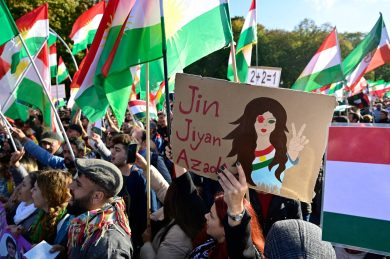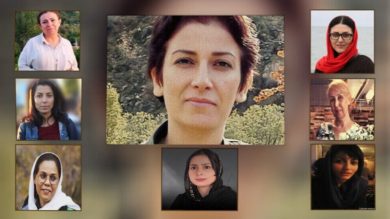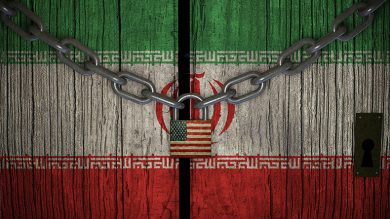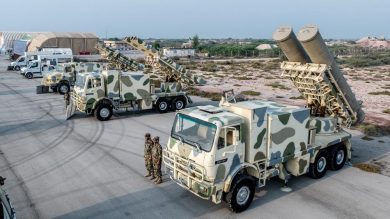For decades, the Islamic Revolutionary Guard Corps (IRGC) has been the primary enforcer of gender-based oppression in Iran. Women in the country face systematic discrimination, imposed through mandatory dress codes, restricted freedoms, and state-sanctioned violence. The IRGC’s role in suppressing women’s rights is well-documented, from arresting activists to brutally silencing protests.
The “Women, Life, Freedom” movement, sparked by the death of Mahsa Amini in 2022, has intensified the IRGC’s crackdown on women. Using tactics of fear and control, the regime has arrested, imprisoned, tortured, and killed women who defy its laws. Yet, Iranian women refuse to be silenced, continuing their resistance both on the streets and online.
This report explores:
• How the IRGC enforces gender-based oppression.
• The brutal tactics used to silence women activists.
• Stories of women targeted by the IRGC.
• The role of digital surveillance and censorship.
• How the world can support Iranian women in their fight for freedom.
1. The IRGC’s Role in Enforcing Gender Oppression
A. Mandatory Hijab and the Morality Police
The mandatory hijab law, imposed after the 1979 Islamic Revolution, has been a symbol of state control over women’s bodies. The IRGC, through its Basij forces and the morality police (Gasht-e Ershad), ensures compliance by:
• Harassing women in public for “improper hijab.”
• Using surveillance cameras to monitor streets and public places.
• Arresting women who refuse to comply.
Women who resist are often beaten, fined, or imprisoned. The case of Mahsa Amini, who was arrested and later died in police custody, exposed the brutality of the morality police and triggered nationwide protests.
B. Arbitrary Arrests and Imprisonment
The IRGC actively targets women activists, journalists, and lawyers who advocate for gender equality. Common charges include:
• “Propaganda against the state”
• “Acting against national security”
• “Encouraging corruption and prostitution” (used against women who remove their hijabs)
Women arrested by the IRGC often face years in prison, harsh conditions, and psychological torture to break their spirit.
C. Sexual Violence as a Weapon
Reports from former prisoners detail how the IRGC uses sexual violence as a method of control and punishment. Detainees have described:
• Threats of rape during interrogations
• Sexual assault in detention centers
• Forced virginity tests on female prisoners
This systematic use of gendered violence aims to instill fear and submission in women who challenge the regime’s authority.
2. Stories of Women Targeted by the IRGC
A. Narges Mohammadi – Imprisoned Nobel Laureate
Narges Mohammadi, a prominent human rights activist and Nobel Peace Prize laureate, has been imprisoned multiple times for:
• Speaking out against gender apartheid.
• Campaigning against the death penalty.
• Supporting political prisoners.
Despite enduring torture, solitary confinement, and repeated arrests, she remains a powerful voice for women’s rights in Iran.
B. Nasrin Sotoudeh – The Human Rights Lawyer
Lawyer Nasrin Sotoudeh has defended countless women activists and political prisoners. In 2019, she was sentenced to 38 years in prison and 148 lashes for:
• Defending women arrested for removing their hijabs.
• Speaking against IRGC brutality.
• Advocating for legal reforms.
Her case exemplifies how the IRGC targets those who legally challenge its authority.
C. Sepideh Gholian – Journalist and Activist
Journalist Sepideh Gholian was arrested for reporting on labor rights protests and has faced torture and forced confessions in IRGC custody. Upon her release, she boldly:
• Stood outside Evin Prison and chanted anti-regime slogans.
• Exposed the IRGC’s mistreatment of prisoners.
• Continued activism despite threats and re-arrest.
Her bravery reflects the unbreakable resistance of Iranian women against oppression.
3. Digital Surveillance and Censorship
The IRGC has intensified online repression, fearing that social media empowers women to mobilize protests and expose state violence.
A. Internet Blackouts and Online Censorship
• The IRGC regularly shuts down the internet during major protests to disrupt organization efforts.
• Social media platforms are blocked, requiring VPNs to bypass restrictions.
• Online activists are tracked, arrested, and interrogated for sharing anti-regime content.
Despite this, Iranian women continue using Twitter, Instagram, and Telegram to spread their message to the world.
B. Cyber Attacks and Digital Threats
• Women activists face hacked accounts, death threats, and online smear campaigns.
• The IRGC creates fake social media accounts to spread misinformation and intimidate activists.
• Exiled journalists and influencers like Masih Alinejad have been targeted for kidnapping plots by IRGC operatives.
The regime’s digital warfare shows how deeply it fears the power of Iranian women’s voices.
4. The World’s Response: How to Support Iranian Women
A. Designate the IRGC as a Terrorist Organization
• The United States has already designated the IRGC as a terrorist group due to its involvement in terrorism and human rights violations.
• Europe and Canada must follow suit to:
✔ Freeze IRGC assets globally.
✔ Restrict travel for IRGC officials.
✔ Cut off financial networks funding oppression.
This is a crucial step in holding the IRGC accountable for crimes against women.
B. Increase Sanctions on the Iranian Regime
• Targeted sanctions should focus on:
✔ IRGC leaders overseeing gender repression.
✔ Companies funding IRGC operations.
✔ State media spreading propaganda.
Sanctions must weaken the regime while avoiding harm to ordinary Iranian citizens.
C. Support Digital Freedom
• Provide secure VPNs and encrypted messaging apps to activists.
• Offer satellite internet access during protests.
• Train Iranian women in cybersecurity to protect their online activism.
The IRGC controls the internet, but the world can help Iranian women stay connected.
D. Amplify Iranian Women’s Voices
• Global media outlets must prioritize coverage of Iran’s women-led resistance.
• Influencers and public figures should share stories from Iranian activists.
• Hashtag campaigns like #WomenLifeFreedom must continue to raise awareness.
The more the world amplifies these voices, the harder it becomes for the IRGC to silence them.
Conclusion: The Fight for Women’s Freedom Continues
Despite the IRGC’s brutality, Iranian women continue to resist—on the streets, in prisons, and online. Their fight is not just about the hijab, but about fundamental human rights, dignity, and freedom.
From Narges Mohammadi’s prison writings to Sepideh Gholian’s fearless activism, these women prove that no amount of repression can silence the demand for justice.
The world must stand with Iranian women, ensuring that their fight for freedom is not just heard, but supported with action.
Join Our Newsletter!
Stay informed with the latest updates, news, and ways to take action in the fight for justice and global security. Sign up now to get updates delivered straight to your inbox!





